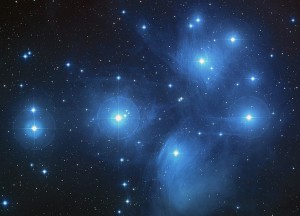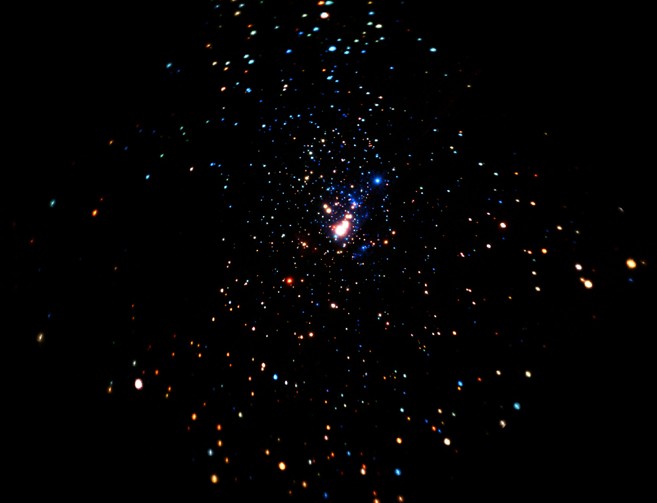Posts Tagged ‘pleiades’
Comet Lovejoy
If you are currently lucky with the weather (we are not in Plymouth!), you should be able to see Comet Lovejoy (Comet C/2014 Q2 Lovejoy) in the night sky now. Ideally, it is best to go to a dark area, such as a moor or rural location, as it will be much easier to see it, although you will probably be able to make it out with the naked eye in a more built up area. The very best way to view it would be to go to a really dark place and have a look at it through some binoculars. It will appear like a glowing green blue ball, due to the fact it is made of ice.
The comet was only discovered last year by an Australian astronomer called Terry Lovejoy, but it has been found to have been orbiting the Sun and is about 44 million miles away from the Earth (as of now). So there is no chance that it will hit us! 😉 The last time it came through our part of the Solar System was 11,500 years ago and it won’t be back for another 8,000 years. We will all be travelling around in space by then I think! It appeared closest to Earth on January 7th, but is still going to be a really good view for at least another 10 days, until it will gradually get fainter and fainter as it moves further away from us.
To find Comet Lovejoy in the Sky, you will need to look towards the South of the Constellation Taurus and to the West of the upper half of the Constellation Orion. As the days go on, it will obviously travel onwards and eventually through the edge of Taurus and near to the Pleiades. It should be pretty straight forward to spot if you know your basic Constellations.
This is a great Comet to view and I am crossing my fingers that our skies clear enough for me to have a good look at it! 😉
The Geminids 2014
Over the weekend was the peak of the annual Geminid Meteor Shower. This year, it was actually clear skies over our house meaning the sky was perfectly clear. In fact, it was the best clear sky that we have had for a very long time! There was no moon and the stars and constellations were twinkling beautifully in the night sky. Of course, being this time of year, it meant the clear sky made the temperature absolutely freezing! In fact, it was minus 1.2 by 22:30 so we were quite chilly stood outside!
My wife and I went out to look on two occasions in the evening. The first viewing lasted for about 45 minutes, starting at about 19:45 on Saturday. I was out on my own at first but didn’t see any meteors until my wife made an appearance, which was about 20 minutes in to the viewing. I did have a great time using my camera to try and take photos of the constellation Cassiopeia and the Pleiades but unfortunately my lens wasn’t big enough, so all I took was darkness. It took me a few minutes to get my bearings on where the meteors would originate from, but found that it was directly behind our house. This meant we could stand on the back step and be looking in the correct direction. The only problem with this was that there is a big house directly behind ours, which blocks out the sky. This meant that we had to look directly up, which gave me neck ache the next day!
Anyway, the first viewing picked up and we eventually saw about 8 meteors. Some were very small flashes in the Sky, whilst others zoomed along and left a nice long tail behind. It was great, but we eventually got so cold that we had to go in and have a hot chocolate to drink!
We went back outside at about 10pm for about 30 minutes, by which time the rate of meteors passing by must have picked up as we were treated to some really good ones that shot across the sky and had some amazing tails. The origin of the meteors had passed to the side of the house behind us as well, so we had a clearer view of Gemini by then. I have to say that the constellation Orion looked excellent and very bright as well, which was to the south east of Gemini. At one point we must have seen about 3 big meteors in the space of about 15 seconds, and they were all over the sky. It was great! But, as mentioned above, the temperature had reached sub zero levels by now, and we were just too cold, so we called it a night. In this time we saw about 10 really good meteors, which was very pleasing.
The Geminid Meteor Shower of 2014 was probably the best one that we have seen from our house in Plymouth. The moon was down, the sky was dark and the starts shone so brightly. It was an amazing sight, and to see lots of meteors as well topped it of brilliantly! Here’s hoping for more nights like this when future meteor showers are due! 😉
1st Star Gaze Of The Year
After several months of pants weather in the evenings which stopped me from doing any stargazing, last night finally had a clear enough sky to have a good look again. The moon was ideally positioned as well which made the stars and planets on show very bright. I didn’t get the telescope out this time but used my binoculars instead to have a scan around the Sky.
The most noticeable object in the Sky was the planet Jupiter which was shining very brightly, so I had a good look at it and managed to pick out three of Jupiter’s moons. One was to the right of it and two more underneath it, and I could also just pick out the horizontal storms raging across the planet. As I was using binoculars, the image wasn’t very steady, so I was desperately trying to lean against the shed to steady myself!
Once I had had a good look at Jupiter, I had a look at the Pleiades (also known as ‘The Seven Sisters’) which are one of my favourite things to view in the night sky. They were shining brilliantly via the binoculars although quite dimmed out when looking with the naked eye. It still amazes me how well you can see these stars through a telescope or binoculars as it really brings them to life! The Pleiades are located in the constellation of Taurus and are one of the closest star clusters to Earth. Here is a great photo of them from the NASA website.
The final section of the sky that I had a good look at last night was the Orion Nebula which is situated in the sword of the constellation Orion. As the Nebula is in the middle of the three star sword, it is easily spotted in the sky. You can just make out a blurry area with the naked eye, but using the binoculars as I was, I had a great view of the Nebula. The Nebula is also known as M42 and is 24 light years across with the mass being almost 2000 times that of the Sun. It is also the closest star forming region to the Earth which adds to its significance. I find it amazing to look at this and imagine new stars and worlds being formed in a distant part of the galaxy. Here is a photo of the Orion Nebula from the NASA website.
Here’s hoping for more clear skies over the next few weeks!
Comet Spotting – Attempt #3
Last night we went out again to try and find Comet Pan-Starrs as it was a clear night, but unfortunately, we didn’t manage to see it. There was a band of cloud along the horizon where I am sure the Comet would have been, and it was also very frosty so the atmosphere of the Earth wasn’t as clear as it had been the previous nights when we have been out. It was a bit of a shame, but we at least saw the Comet on our second attempt which was great!
Instead last night, we had a look around at the other objects in the Sky with our binoculars. Jupiter was very bright and you could see a couple of it’s Moon’s shining beside it, and we also had a good look at the Pleiades (also known as the ‘Seven Sisters’ as they are a group of seven stars that shine very brightly. The Pleiades were clear as a bell through the binoculars and were a great site! Finally, we had a go at looking for the Orion Nebula and that was showing really well. You could see a blurry, but large, mass of stars which make up the Nebula in the sword of the Constellation Orion (just south of Orion’s belt). It was a great view!
So whilst we were annoyed we couldn’t see the Comet again, we had a good time looking at some of the other features that make up the night sky!

